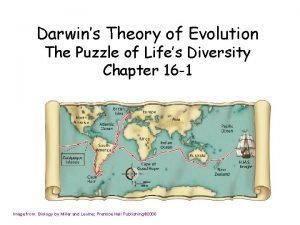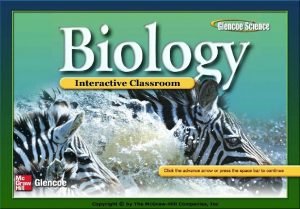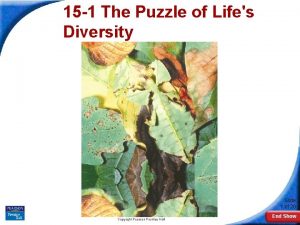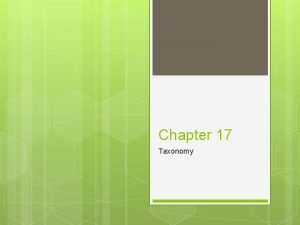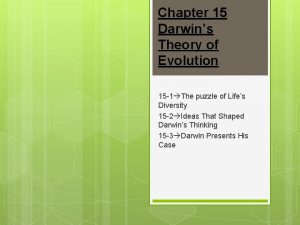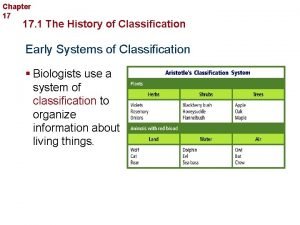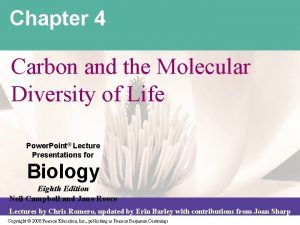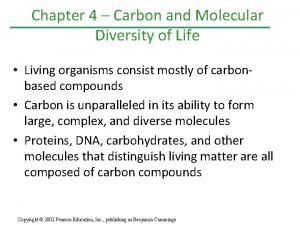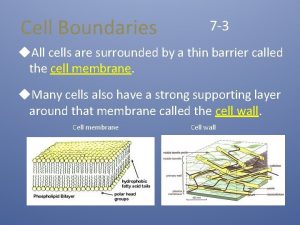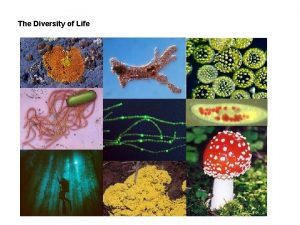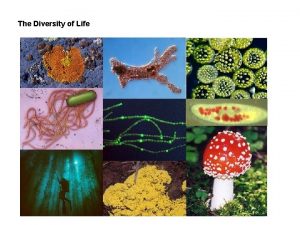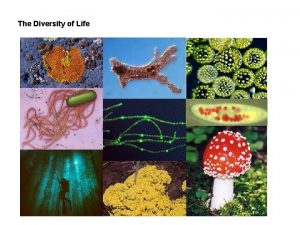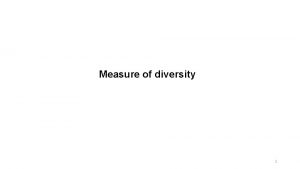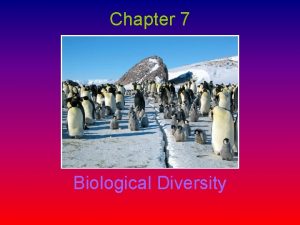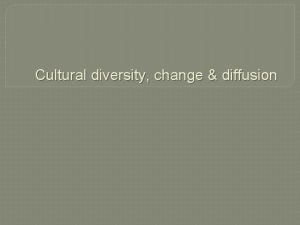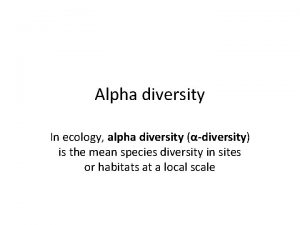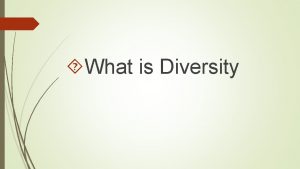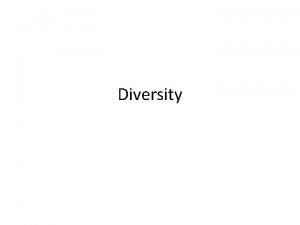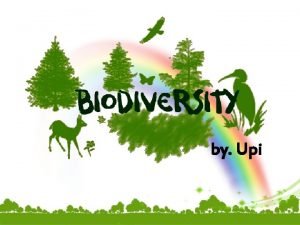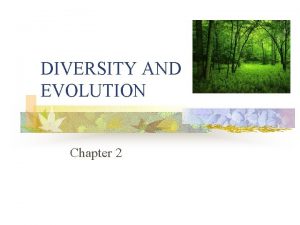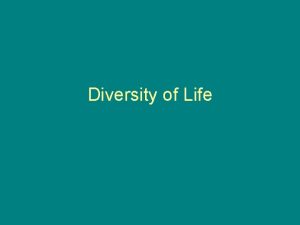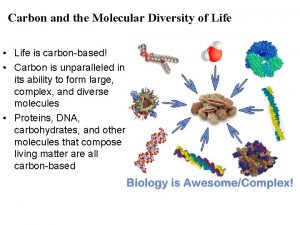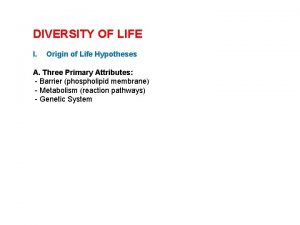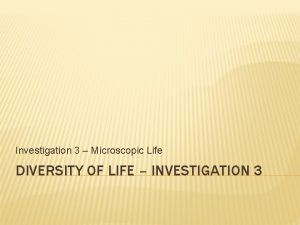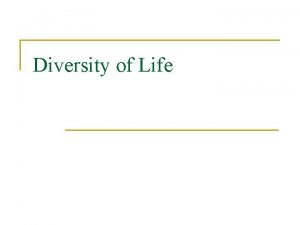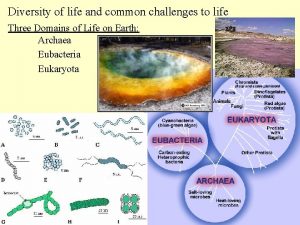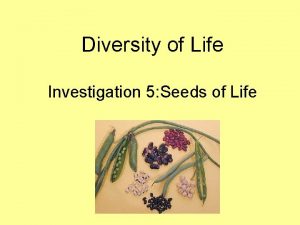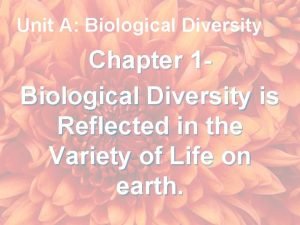The Diversity of Life The Diversity of Life







































- Slides: 39

The Diversity of Life

The Diversity of Life I. A Brief History of Life II. Classifying Life III. The Prokaryotic Domains

Ecological Roles Played By Prokaryotes The Diversity of Life I. A Brief History of Life ATMOSPHERE A. Introduction N fixation Photosynthesis BIOSPHERE Absorption LITHOSPHERE Respiration Energy harvest of animals and plants Decomposition

The Diversity of Life I. A Brief History of Life 4. 5 bya: Earth Forms A. Introduction B. Timeline

The Diversity of Life I. A Brief History of Life 4. 0 bya: Oldest Rocks 4. 5 bya: Earth Forms A. Introduction B. Timeline

The Diversity of Life I. A Brief History of Life 3. 5 bya: Oldest Fossils 4. 0 bya: Oldest Rocks 4. 5 bya: Earth Forms A. Introduction B. Timeline

The Diversity of Life I. A Brief History of Life 3. 5 bya: Oldest Fossils 4. 0 bya: Oldest Rocks 4. 5 bya: Earth Forms A. Introduction B. Timeline Stromatolites - communities of layered 'bacteria'

2. 3 -2. 0 bya: Oxygen in Atmosphere 3. 5 bya: Oldest Fossils 4. 0 bya: Oldest Rocks 4. 5 bya: Earth Forms The Diversity of Life I. A Brief History of Life A. Introduction B. Timeline

The Diversity of Life I. A Brief History of Life 2. 3 -2. 0 bya: Oxygen 2. 0 bya: first eukaryotes 3. 5 bya: Oldest Fossils 4. 0 bya: Oldest Rocks 4. 5 bya: Earth Forms A. Introduction B. Timeline Grypania spiralis – possibly a multicellular algae, dating from 2. 0 by

The Diversity of Life I. A Brief History of Life A. Introduction B. Timeline The classical model of endosymbiosis explains the origin of eukaryotes as the endosymbiotic absorption/parasitism of archaeans by free-living bacteria.

The Diversity of Life I. A Brief History of Life A. Introduction B. Timeline - Life was exclusively bacterial for ~40% of life’s 3. 5 by history - Ecosystems evolved with bacterial producers, consumers, and decomposers. - Multicellular eukaryotic organisms evolved that use and depend on these bacteria

0. 7 bya: first animals 2. 3 -2. 0 bya: Oxygen 2. 0 bya: first eukaryotes 3. 5 bya: Oldest Fossils 4. 0 bya: Oldest Rocks 4. 5 bya: Earth Forms The Diversity of Life I. A Brief History of Life A. Introduction B. Timeline

0. 7 bya: first animals 0. 5 bya: Cambrian 2. 3 -2. 0 bya: Oxygen 2. 0 bya: first eukaryotes 3. 5 bya: Oldest Fossils 4. 0 bya: Oldest Rocks 4. 5 bya: Earth Forms The Diversity of Life I. A Brief History of Life A. Introduction B. Timeline

0. 7 bya: first animals 0. 5 bya: Cambrian 0. 24 bya: Mesozoic 2. 3 -2. 0 bya: Oxygen 2. 0 bya: first eukaryotes 3. 5 bya: Oldest Fossils 4. 0 bya: Oldest Rocks 4. 5 bya: Earth Forms The Diversity of Life I. A Brief History of Life A. Introduction B. Timeline

0. 7 bya: first animals 0. 5 bya: Cambrian 0. 24 bya: Mesozoic 0. 065 bya: Cenozoic 2. 3 -2. 0 bya: Oxygen 2. 0 bya: first eukaryotes 3. 5 bya: Oldest Fossils 4. 0 bya: Oldest Rocks 4. 5 bya: Earth Forms The Diversity of Life I. A Brief History of Life A. Introduction B. Timeline

0. 7 bya: first animals 0. 5 bya: Cambrian 0. 24 bya: Mesozoic 0. 065 bya: Cenozoic 2. 3 -2. 0 bya: Oxygen 2. 0 bya: first eukaryotes 3. 5 bya: Oldest Fossils 4. 0 bya: Oldest Rocks 4. 5 bya: Earth Forms The Diversity of Life I. A Brief History of Life 4. 5 million to present A. Introduction B. Timeline (1/1000 th of earth history)

For ~40% of life’s history, life was exclusively bacterial 0. 7 bya: first animals 0. 5 bya: Cambrian 0. 24 bya: Mesozoic 0. 065 bya: Cenozoic 2. 3 -2. 0 bya: Oxygen 2. 0 bya: first eukaryotes 3. 5 bya: Oldest Fossils 4. 0 bya: Oldest Rocks 4. 5 bya: Earth Forms The Diversity of Life I. A Brief History of Life A. Introduction B. Timeline

The Diversity of Life I. A Brief History of Life II. Classifying Life A. The Linnaean System - a ‘nested’ hierarchy based on morphology

The Diversity of Life I. A Brief History of Life II. Classifying Life Genus Felis A. The Linnaean System - a ‘nested’ hierarchy based on morphology Acinonyx Lynx Panthera Family Felidae

The Diversity of Life I. A Brief History of Life II. Classifying Life A. The Linnaean System B. Cladistics and Phylogenetic Systematics Evolution explained this nested pattern as a consequence of descent from common ancestors. Modern biologists view the classification system as a means of showing the phylogenetic relationships among groups

The Diversity of Life I. A Brief History of Life II. Classifying Life Genus Felis A. The Linnaean System B. Cladistics and Phylogenetic Systematics But there are inconsistencies to correct: Cougar (Felis concolor) is in the genus Felis but is biologically more closely related to Cheetah (which are in another genus), than to other members of the genus Felis. The goal is to make a monophyletic classification system, in which descendants of a common ancestor are in the same taxonomic group. Acinonyx Lynx Panthera Family Felidae

The Diversity of Life I. A Brief History of Life II. Classifying Life Genus Felis A. The Linnaean System B. Cladistics and Phylogenetic Systematics The goal is to make a monophyletic classification system, in which descendants of a common ancestor are in the same taxonomic group. * * Now, all members of the genus Felis share one common ancestor. Genus Panthera Family Felidae

The Diversity of Life I. A Brief History of Life II. Classifying Life A. The Linnaean System B. Cladistics and Phylogenetic Systematics The goal is to make a monophyletic classification system, in which descendants of a common ancestor are in the same taxonomic group. OLD NEW HOMINIDAE PONGIDAE Genera: Australopithecus Homo Genera: Pan Gorilla Pongo

The Diversity of Life I. A Brief History of Life II. Classifying Life A. The Linnaean System B. Cladistics and Phylogenetic Systematics The goal is to make a monophyletic classification system, in which descendants of a common ancestor are in the same taxonomic group. OLD Phylum: Chordata Subphylum: Vertebrata Class: Reptilia Class: Mammalia Class: Aves

The Diversity of Life I. A Brief History of Life II. Classifying Life A. The Linnaean System B. Cladistics and Phylogenetic Systematics NEW

The Diversity of Life I. A Brief History of Life II. Classifying Life A. The Linnaean System B. Cladistics and Phylogenetic Systematics The goal is to make a monophyletic classification system, in which descendants of a common ancestor are in the same taxonomic group. OLD

The Diversity of Life I. A Brief History of Life II. Classifying Life A. The Linnaean System B. Cladistics and Phylogenetic Systematics The goal is to make a monophyletic classification system, in which descendants of a common ancestor are in the same taxonomic group. NEW

III. The Prokaryote Domains: Eubacteria and Archaea A. Overview

III. The Prokaryote Domains: Eubacteria and Archaea A. Overview “Horizontal Gene Transfer” complicates phylogenetic reconstruction in prokaryotes and dating these vents by genetic similarity and divergence.

III. The Prokaryote Domains: Eubacteria and Archaea A. Overview Bacteria Archaea Eukarya No nucleus no organelles peptidoglycan no no 1 RNA Poly several F-methionine Introns rare present common No histones Circular X’some Linear X’some

III. The Prokaryote Domains: Eubacteria and Archaea A. Overview 1. Archaea “Extremeophiles” - extreme thermophiles: sulphur springs and geothermal vents - extreme halophiles: salt flats “Methanogens” Also archaeans that live in benign environments across the planet.

III. The Prokaryote Domains: Eubacteria and Archaea A. Overview 1. Archaea 2. Bacteria - proteobacteria - Chlamydias - Spirochetes - Cyanobacteria - Gram-positive bacteria

III. The Prokaryote Domains: Eubacteria and Archaea A. Overview 1. Archaea 2. Bacteria These groups are very diverse genetically and metabolically. Their genetic diversity is represented by the “branch lengths” of the groups, showing how different they are, genetically, from their closest relatives with whom they share a common ancestor.

III. The Prokaryote Domains: Eubacteria and Archaea A. Overview B. Metabolic Diversity of the Prokaryotes The key thing about bacteria is their metabolic diversity. Although they didn't radiate much morphologically (spheres, rod, spirals), they DID radiate metabolically. As a group, they are the most metabolically diverse group of organisms.

III. The Prokaryote Domains: Eubacteria and Archaea A. Overview B. Metabolic Diversity of the Prokaryotes 1. Oxygen Demand all eukaryotes require oxygen.

III. The Prokaryote Domains: Eubacteria and Archaea A. Overview B. Metabolic Diversity of the Prokaryotes 1. Responses to Oxygen: all eukaryotes require oxygen. bacteria show greater variability: - obligate anaerobes - die in presence of O 2 - aerotolerant - don't die, but don't use O 2 - facultative aerobes - can use O 2, but don't need it - obligate aerobes - require O 2 to live

III. The Prokaryote Domains: Eubacteria and Archaea A. Overview B. Metabolic Diversity of the Prokaryotes 1. Responses to Oxygen: 2. Nutritional Categories: - chemolithotrophs: use inorganics (H 2 S, etc. ) as electron donors for electron transport chains and use energy to fix carbon dioxide. Only done by bacteria. - photoheterotrophs: use light as source of energy, but harvest organics from environment. Only done by bacteria. - photoautotrophs: use light as source of energy, and use this energy to fix carbon dioxide. bacteria and some eukaryotes. - chemoheterotrophs: get energy and carbon from organics they consume. bacteria and some eukaryotes.

III. The Prokaryote Domains: Eubacteria and Archaea A. Overview B. Metabolic Diversity of the Prokaryotes C. Ecological Importance - major photosynthetic contributors (with protists and plants) - the only organisms that fix nitrogen into biologically useful forms that can be absorbed by plants. - primary decomposers (with fungi) - pathogens - endosymbionts with animals, protists, and plants

Bacteria still drive major dynamics of the biosphere
 Genetic diversity vs species diversity
Genetic diversity vs species diversity Genetic diversity vs species diversity
Genetic diversity vs species diversity Section 15-1 the puzzle of life's diversity answers
Section 15-1 the puzzle of life's diversity answers Diversity and interdependence of life
Diversity and interdependence of life Section 15-1 the puzzle of life's diversity answer key
Section 15-1 the puzzle of life's diversity answer key Organizing life's diversity section 3 domains and kingdoms
Organizing life's diversity section 3 domains and kingdoms 15-1 the puzzle of life's diversity
15-1 the puzzle of life's diversity Organizing life's diversity
Organizing life's diversity Section 15-1 the puzzle of life's diversity answer key
Section 15-1 the puzzle of life's diversity answer key Chapter 17 organizing life's diversity answer key
Chapter 17 organizing life's diversity answer key Define biodiversity conservation
Define biodiversity conservation Section 7-4 the diversity of cellular life
Section 7-4 the diversity of cellular life Carbon and the molecular diversity of life
Carbon and the molecular diversity of life Chapter 4 carbon and the molecular diversity of life
Chapter 4 carbon and the molecular diversity of life Section 7-4 the diversity of cellular life
Section 7-4 the diversity of cellular life Hát kết hợp bộ gõ cơ thể
Hát kết hợp bộ gõ cơ thể Frameset trong html5
Frameset trong html5 Bổ thể
Bổ thể Tỉ lệ cơ thể trẻ em
Tỉ lệ cơ thể trẻ em Gấu đi như thế nào
Gấu đi như thế nào Chụp tư thế worms-breton
Chụp tư thế worms-breton Alleluia hat len nguoi oi
Alleluia hat len nguoi oi Môn thể thao bắt đầu bằng từ đua
Môn thể thao bắt đầu bằng từ đua Thế nào là hệ số cao nhất
Thế nào là hệ số cao nhất Các châu lục và đại dương trên thế giới
Các châu lục và đại dương trên thế giới Công thức tiính động năng
Công thức tiính động năng Trời xanh đây là của chúng ta thể thơ
Trời xanh đây là của chúng ta thể thơ Cách giải mật thư tọa độ
Cách giải mật thư tọa độ Làm thế nào để 102-1=99
Làm thế nào để 102-1=99 độ dài liên kết
độ dài liên kết Các châu lục và đại dương trên thế giới
Các châu lục và đại dương trên thế giới Thể thơ truyền thống
Thể thơ truyền thống Quá trình desamine hóa có thể tạo ra
Quá trình desamine hóa có thể tạo ra Một số thể thơ truyền thống
Một số thể thơ truyền thống Cái miệng nó xinh thế chỉ nói điều hay thôi
Cái miệng nó xinh thế chỉ nói điều hay thôi Vẽ hình chiếu vuông góc của vật thể sau
Vẽ hình chiếu vuông góc của vật thể sau Biện pháp chống mỏi cơ
Biện pháp chống mỏi cơ đặc điểm cơ thể của người tối cổ
đặc điểm cơ thể của người tối cổ Thế nào là giọng cùng tên
Thế nào là giọng cùng tên Vẽ hình chiếu đứng bằng cạnh của vật thể
Vẽ hình chiếu đứng bằng cạnh của vật thể




